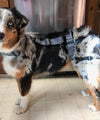Recent Post
Archive
- February 2025
Tags

Should I Spay, or Should I No? The Great Debate Around Early Spaying
Dexter Blanch
Nov 20, 2024

Recently, The Washington Post published an article Spay or neuter your dog, right? NOT SO FAST. about the great debate of spaying or neutering a dog. In current times it’s not a quick decision to spay/neuter a dog. There are many concerns that come with making the decision to alter a dog’s body. Timing, health, and behavioral issues are just the surface of considering problems that can occur. To spay/neuter or to not, that’s the most difficult choice a pet parent makes once they bring home their puppy. It’s become common practice for shelters and rescue centers to desex canines and felines before they are rehomed
Some of the behavioral issues that can develop after spaying/neutering your dog include:
An increase in aggression. Animals that were closely monitored show double the amount of aggression that they had before after having surgery. They may act aggressively to humans or other animals. Some spayed dogs act aggressively to both.
An increase in fearfulness. Your usually happy pup may seem timid or scared. She may not fully understand what happened to her and think that it may happen again.
Along with behavioral issues, physical issues can develop as well. Some of the physical issues include:
Hip Dysplasia. Numerous studies in the past few decades have linked hip dysplasia with spaying pets six months old and younger. The painful condition can lead to joint diseases which cause pain and affect mobility.
Cancer. Young dogs who were spayed prematurely have a nine times higher risk of hemangiosarcoma than those who remain intact. The study also proved that the dogs were 3.5 times more likely to develop cell cancer as well as 4.3 times more likely to develop lymphoma.
The other options
Vasectomy- it is not widely performed yet and it’s the best way to sterilize male dogs to allow their growth plates to close and also allow for their hormones to fully develop.
Hysterectomy- hormones are kept and the dog will still go into heat, however, no discharge or blood will appear. This procedure also lowers the chances of health issues.
For those who are interested in avoiding unwanted pregnancies with an unspayed dog, or want to avoid surgery at all cost, there’s a tool that’s been developed by “PABS Delay her Spay” which is pretty much a canine “chastity belt” check it out at delayherspay.com!
As always, the health of your dog is most important to us. Consult with your veterinarian about the best choices for your dog.
- beagler, beagling, breeding dogs, Can you get a dog spayed after her first heat, chastity belts, complications of spaying a dog, early spay and neuter considerations, heat cycle, is getting a dog spayed safe, is getting a puppy spayed safe, my puppy resource, my puppy wellness, puppy supplies, Spay and Neuter, spay dog, spay dogs in heat, spaying., when to spay my dog, when to spay my puppy
← Older Post Newer Post →



